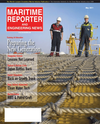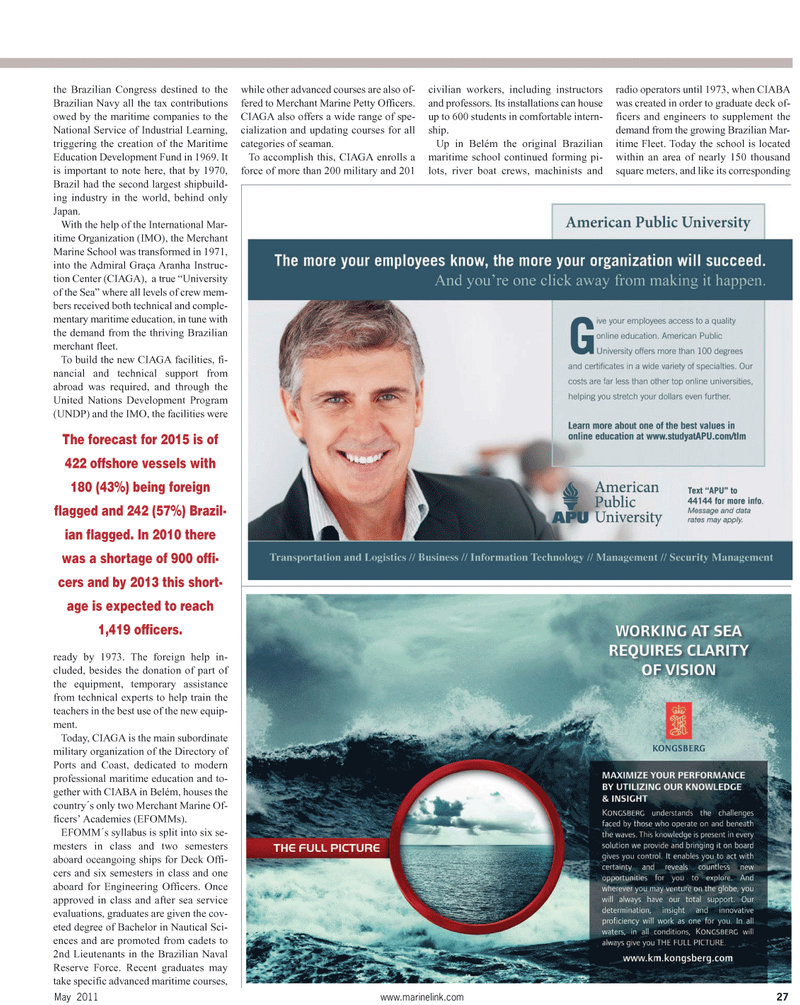
Page 27: of Maritime Reporter Magazine (May 2011)
Training & Education Edition
Read this page in Pdf, Flash or Html5 edition of May 2011 Maritime Reporter Magazine
May 2011 www.marinelink.com 27 the Brazilian Congress destined to the
Brazilian Navy all the tax contributions owed by the maritime companies to the
National Service of Industrial Learning, triggering the creation of the Maritime
Education Development Fund in 1969. It is important to note here, that by 1970,
Brazil had the second largest shipbuild- ing industry in the world, behind only
Japan.
With the help of the International Mar- itime Organization (IMO), the Merchant
Marine School was transformed in 1971, into the Admiral Graça Aranha Instruc- tion Center (CIAGA), a true “University of the Sea” where all levels of crew mem- bers received both technical and comple- mentary maritime education, in tune with the demand from the thriving Brazilian merchant fleet.
To build the new CIAGA facilities, fi- nancial and technical support from abroad was required, and through the
United Nations Development Program (UNDP) and the IMO, the facilities were ready by 1973. The foreign help in- cluded, besides the donation of part of the equipment, temporary assistance from technical experts to help train the teachers in the best use of the new equip- ment.
Today, CIAGA is the main subordinate military organization of the Directory of
Ports and Coast, dedicated to modern professional maritime education and to- gether with CIABA in Belém, houses the country´s only two Merchant Marine Of- ficers’ Academies (EFOMMs).
EFOMM´s syllabus is split into six se- mesters in class and two semesters aboard oceangoing ships for Deck Offi- cers and six semesters in class and one aboard for Engineering Officers. Once approved in class and after sea service evaluations, graduates are given the cov- eted degree of Bachelor in Nautical Sci- ences and are promoted from cadets to 2nd Lieutenants in the Brazilian Naval
Reserve Force. Recent graduates may take specific advanced maritime courses, while other advanced courses are also of- fered to Merchant Marine Petty Officers.
CIAGA also offers a wide range of spe- cialization and updating courses for all categories of seaman.
To accomplish this, CIAGA enrolls a force of more than 200 military and 201 civilian workers, including instructors and professors. Its installations can house up to 600 students in comfortable intern- ship.
Up in Belém the original Brazilian maritime school continued forming pi- lots, river boat crews, machinists and radio operators until 1973, when CIABA was created in order to graduate deck of- ficers and engineers to supplement the demand from the growing Brazilian Mar- itime Fleet. Today the school is located within an area of nearly 150 thousand square meters, and like its corresponding
The forecast for 2015 is of 422 offshore vessels with 180 (43%) being foreign flagged and 242 (57%) Brazil- ian flagged. In 2010 there was a shortage of 900 offi- cers and by 2013 this short- age is expected to reach 1,419 officers.

 26
26

 28
28
